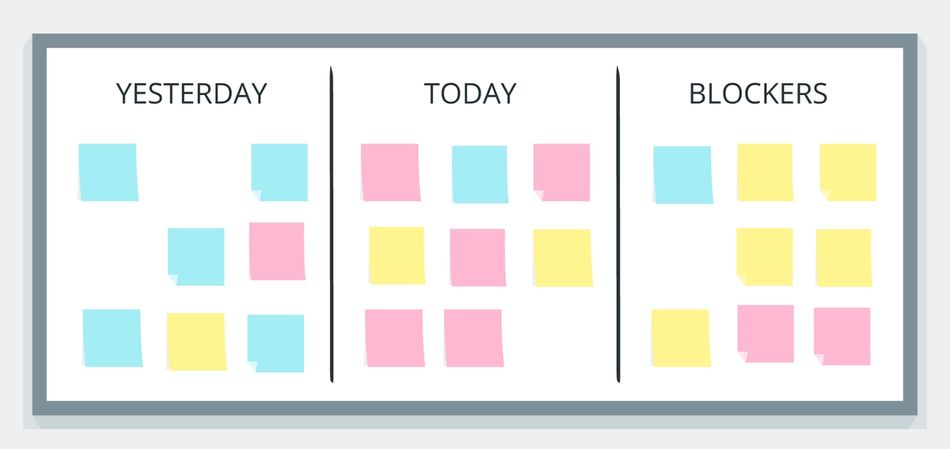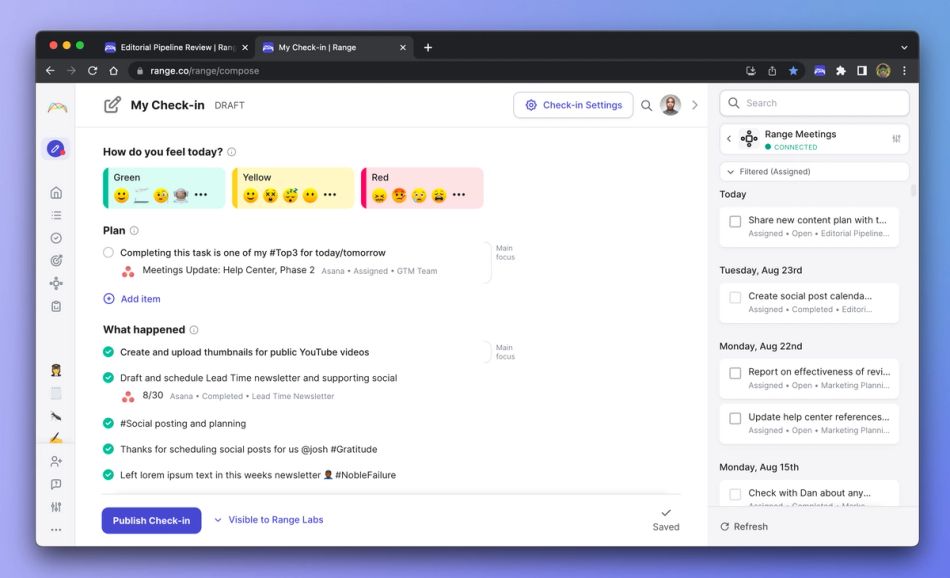
Standup meetings are one example of a daily ritual that can make - or break - a team’s effectiveness over time.
A daily standup meeting is a team meeting that is held every day, typically first thing in the morning. The purpose of the daily standup meeting is to discuss what everyone is working on and to identify any obstacles that are preventing progress.
While inefficient stand-ups can limit a team’s ability to accomplish their goals, effective daily stand-ups empower teams with a strong foundation for long-term success.
In this post, you'll learn:
- How to run daily standup meetings
- Tips for avoiding common standup struggles
- Free templates and tools to help you build better standup habits
How much are standups costing you in wasted hours? 🤷
Try the Standup Cost Calculator & save big 💰
What is the purpose of a daily standup?
The purpose of a standup is to bring teams together to share developments, surface blockers, and move work forward. It’s about empowering team members and building accountability. It’s a meeting that’s in direct service of moving toward completion quickly, without hiccups. Everyone who participates in the standup should understand this, and get value out of the time spent together.
Standups help teams align strategy with execution-something that only 8% of team leaders are naturally good at. They help teams and leaders avoid messy situations around priorities, by answering questions like:
- What exactly needs to be worked on?
- What is everyone else working on?
- Do we understand where we’re going?
- Are people “rowing in the same direction?”
- What’s the broader strategy and how does that look at the task-execution level?
Recurring standup meetings give teams a focused way to align around what is happening in the business, plan daily work accordingly, and remove blockers.
Daily standup meetings are a space for small groups to come together to move projects forward. They’re more focused and concise than other meetings and follow the same structure every time.
Remember, the goal is to keep the meeting short and relevant.
All-hands, 1:1's, and other forums are much better times to broadcast exciting findings or go deep on collaborative brainstorming.
If it feels necessary for an attendee to share detailed context on their work during the standup, chances are there may be a lack of clarity on why something is being worked on in the first place.
What is the structure of a standup meeting?
Daily Standup meeting (n): A short meeting meant to keep teams aligned and quickly resolve issues.
Synonyms: daily scrum, stand-up, daily huddle, morning roll-call, quick sync
Other names:
- Daily scrum
- Daily agile meeting
- Morning roll-call
- Morning huddle
- Quick sync–
- ...or you might be new to standups all together.
The agenda of a standup meeting is designed to be short, and — ideally — it’s baked deeply into the process of the organization: everyone arrives at a certain time, the standup begins at a certain time, and the standup lasts 15 minutes or less.
3 questions for standup or scrum meeting:
- What did you do yesterday?
- What will you do today?
- What blockers stand in your way?
Here’s an example of how one might respond to these standup questions:
- What did you do yesterday?
“Yesterday, I focused on finalizing the specs for the Fletcher project.” - What will you do today?
“Today, I am continuing to support Briana from dev on making sure the Fletcher project is moving forward.” - What blockers stand in your way?
“Briana and I could use another set of eyes on the technical brief I’ve drafted.”
Quick and concise. Move to the next attendee.
While the three cornerstone questions help give structure and purpose to any standup, the following tips can be useful for team leaders looking for more ways to keep standups as efficient and effective as possible:
- Time it right — Keep the standup to 15 minutes maximum.
- Be professional — This covers your arrival time, listening to colleagues, and standing up for the meeting.
- Be valuable — Everything you say should be valuable to a majority, if not the entirety, of the people participating in the daily standup. If you are exclusively talking to one other person or about yourself, that is not broadly valuable and those conversations can easily happen after the meeting.
- Call “Tangent!” — Everyone should be empowered to call “Tangent!” to break up a 1-on-1 that’s not valuable for the whole team, or to redirect someone listing every meeting they have that day.
- Involve remote employees — This will vary based on conference room layout and who began the meeting, but remote teammates need a dedicated slice of the overall 15 minutes. Whoever leads the meeting (your scrum master) calls on remote team members to contribute at a certain point in the meeting.
- Go to the source — Having a source of truth where team members share blockers, plans, and works in progress before a daily standup (or even in place of one) can help teams spend synchronous time on what matters most. Technology tools like Range enable teams to connect in context by capturing the full scope of what and how everyone is doing.
The daily standup meeting agenda
Here is a great 15-minute daily standup meeting agenda template that you can follow for your daily standup.
- Icebreaker-Start with a brief team building question to build connection and give everyone a chance to speak (3 min)
- Project updates-Share updates that are relevant to the entire group, not everyone will have an update every time (5 min)
- Surface issues and blockers & answer the 3 cornerstone questions (5 min)
- Assign action items (2 min)
Tip: Start in writing
At Range, we’ve experimented with a lot different standup formats. After plenty of trial and error, we’ve found it most helpful to have folks share written updates (and read each other’s) asynchronously, before the live meeting (if you choose to do one)
With these asynchronous daily standups, we’re already aligned on basic status updates, so meeting time can be spent tackling blockers and connecting with our teammates.
Every month, the host of the daily standup — typically an account or project manager — should meet with senior leaders about what’s working well and not so well with the meeting. Solicit feedback and try to improve the process and the agenda for the benefit of everyone.
What does a good standup meeting look like in practice?
- Well-structured - With a clear agenda, guiding questions, and a format that actually works for your team. See the pointers above
- Good use of everyone’s time - It unblocks ICs and helps everyone on the team get their work done, without compromising focus time. The standup creates a permission structure to talk openly about what's getting in the way of progress.
- Ensures honesty - This permission structure is doubly important for those who may feel uncomfortable sharing something that can be read as a ‘negative’ for fear of repercussions. Vulnerability plays a huge role in this type of workplace interaction.
- Works for in-person or remote teams - It’s flexible and inclusive of different communication styles, personalities, and timezones
- Helps your team get more done - It’s not just a time to show the manager what everyone’s working on, it actually improves productivity
- Empowers ICs - The number one outcome for every standup meeting should be making sure that everyone on your team can get support to unblock themselves.
- No micromanaging - The actions of these types of managers - which can stem from a lack of trust, a need to control, or low self-esteem - are the opposite of the principles that fuel effective standups: trust, self-regulation, and openness. Too often, the need for a project manager to be the center of attention and feel like they're running the show can derail this daily sync from providing the opportunity for others to speak up and solve problems.
What are the benefits of a daily standup meeting?
Standups empower teams in a number of key ways.
- Help a project team move from point A to point B faster
- Allow leadership and teams to connect strategy to execution
- Surface blockers quickly, before they become a real issue
- Improve team-wide communication and collaboration
- Promote team and individual accountability
- Give everyone on the team greater visibility into in-flight work
- Allow teams to reach goals faster and more effectively
What are common problems with daily standups?
Have you ever attended a standup just for the sake of reporting upwards on your work? Has your 15-minute agile team meeting morphed into an hour-long round robin over Zoom?
Have you skipped a daily scrum because it feels like a waste of time? If so, you’re not alone.
Look at this Reddit thread.
In fact, many of the largest tech companies no longer or never have used the agile and scrum methodology.
As more teams adopt standups, many share the quiet feeling that the meeting itself has become a blocker. Here are some of the most common pitfalls.
- Going over time (either because the attendee list is too large or because discussion or updates lose focus)
- Getting derailed by side conversations
- Sharing updates that are only relevant to a handful of folks in the room
- Sharing repetitive updates over the course of multiple days
- Lacking engagement or attendance
- Struggling to find a meeting time that works for everyone
- Morphing into a status meeting
Pro Tip: Not a status meeting
Your standup should have a short, intentional agenda, it’s not a space for everyone to simply broadcast their work
If you encounter an organization doing hour-long daily standups, which we have seen on many occasions, those meetings are neither standups nor agile.
How to run a standup meeting with a remote team
This is admittedly a challenge. While organizations have made leaps and bounds here in the past decade — and particularly over the past year. If you are trying to engage remote team members or a hybrid team in a daily stand-up, remember the following:
When you’re not able to physically gather in the same space, it drastically changes the dynamic of a standup. Video meetings can be a downer with Zoom fatigue, as they typically take more time, and are less engaging and more mentally taxing on participants. There are also fewer opportunities to collect an ambient layer of non-verbal communication that comes from being in an office.
- Use an async format - Consider an asynchronous check-in to be inclusive of different time zones, work styles, personalities, and schedules
- Solid videoconferencing - Make sure everyone can see and hear each other. One of the most frustrating things for people during a scrum meeting or standup is when remote attendees need to talk to someone quickly (usually about blockers) and can’t locate them in the room. “Is Jesse there? Jesse?” When this repeatedly happens, it decreases the meeting’s efficiency.
- Easy access - There should be a calendar invite for the stand-up meeting and it should always have the conferencing link in it, so that anyone (especially remote workers) can pop into the invite on any day and easily join the session.
- Moments for bonding - Use team-building questions to help your team get to know each other and feel more connected, even when they’re far apart
- Documentation - Establish a strong recorded history of your standups, so it’s easy for anyone on the team to find information or connect with the right folks when they need to
- Feedback - It’s always important to ask for remote employee feedback on everything so that they feel tethered to the bigger team. Ask them what is good, and not so good, about the meeting. Start with how the technology designed to connect distributed team members is working, then move to the meeting itself: Is it effective? Are people saying valuable things about how work is progressing?
Rethinking your team’s standup
The daily standup meeting has been an indispensable tool for developers since the mid-90s.
All that to say, asking your team to try a new approach is never easy. Routines die hard, and new habits can be even harder to establish. But there are a few small shifts you can start to move towards to make it a bit easier.
For instance, switching the update portion of the meeting (where the team answers a set of standard questions) to a flexible async format makes sense for most teams, and is usually seen as a relatively light lift.
It gives folks more focus time back and allows them to share and read updates on their own time.
We’re in a phase of work where the same openness and experimentation that led to the creation of the standup meeting can also yield new tools and styles of problem solving that are specially built for the needs of today.
Daily standups were never meant to be a ritual that was set in stone. It’s simply a means for boosting productivity by setting your team up for success, but these fundamental tips may help you:
Do: Use standups to build camaraderie & trust
A less obvious benefit of the standup meeting is that it helps teams identify as a team.
People are naturally social beings. Teamwork is built on trust, and in order to sustain that trust, we need to have regular interactions, called belonging cues. Without it, teamwork starts to break down.
As a daily ritual, the standup can play a very important role in strengthening the crucial bonds that drive success.
One way to bolster camaraderie is to build quick icebreakers into your standup or create a rapid fire round where everyone shares something about their morning and what they’re excited about that day. You could even play a lightning fast game.
The point is to offer opportunities for colleagues to strengthen bonds. These bonds are closely tied to work ethic and success.
Don’t: Pressure people to speak
Not everyone will have a meaningful update every session, and that’s okay.
Oftentimes, standup culture has trained us to think that every team member should give a progress update every time. If you’re using the time together most effectively, this may not be the case. Think back to the meeting’s purpose.
If it’s to address blockers and bring folks together, you probably don’t need to have the entire team go around and give status updates during every meeting. To solve for this, many teams choose to share status updates asynchronously-in the form of written updates.
Then, when you come together for an in-person or video standup, you might spend the first 5 minutes answering a team-building question, and then the remaining 10 going through blockers or issues that the whole team can weigh in.
Do: Keep the meeting relevant to everyone in the room
Encourage attendees to connect (after the meeting) if someone has insight about a roadblock that could help resolve the issue. If the offline discussion is useful for the wider team, enlist the person who was blocked to share what they learned in their next update. Remind them to keep it brief. You don’t want to spend a ton of time on details unless they’re relevant.
If a team member wants to collaborate with others on the topic, then encourage them to set up a video collaboration session.
Do: Go to the source
Having a source of truth where team members share blockers, plans, and works in progress before a daily standup (or even in place of one) can help teams spend synchronous time on what matters most.
Meeting tools like Range enable teams to connect in context by capturing the full scope of what and how everyone is doing.
Don’t: Have an in-person standup just to have one
Having a daily meeting is a popular practice and can work well for some teams. There may be plenty of reasons why your team isn’t one of them.
For one thing, they might live across three different time zones and keep different schedules that help each of them do their best work. Some colleagues thrive in the evening and others are quite happy to start at 5 AM. Some managers may have children, and others have roommates or family members they have to tend to throughout the day. The landscape has changed dramatically since the days of being confined to one geolocation and in one office.
Teams are truly global now. Shifting how you measure success away from the number of hours worked and when to the results they produce is a critical component of setting yourself up for success.
This doesn’t mean you need to get rid of the daily standup practice. Instead, you might try moving to an asynchronous format or a combination approach to reduce meetings - where daily updates take a written form and video standups happen at a less frequent cadence to address blockers.
Get your standups back on track with Range
The Check-ins tool in Range makes virtual daily standups easy.
- Shift to async communication so you have fewer meetings
- Create a written record of the 3 core standup questions
- Integrate tools from across your workflow, including Github, Google Docs, Google calendar, and more
- Add tasks from your project management tools
- Log team progress and accomplishments
- Identify blockers

Range will help your team plan and share daily work so that everyone remains in sync and aware of what’s happening.
By offering smart suggestions from its integrations with tools like GitHub and Asana, Range makes it easier for your entire team to collect and share work from all your tools.
You can also raise flags (e.g., blockers) within the product, which directs team members to items that need attention.
If you’ve been experiencing challenges with your scrum or daily standup meeting — or if you’re simply looking to test a new approach — create a free Range check-in today and be on your way to improving how your team runs daily stand-up meetings.
Daily Standup FAQ
Are standups a waste of time? 
In-person standups are a waste of time. Especially if you have a remote team across timezones.
Here are horror stories of 60 minute and 90 minute standups.
A standup with 7 people, each making $130,000 on average, with 4 minutes each to speak, 5x per week takes up $50,000+ year.
Find out how much time your team is wasting on standups with our standup cost calculator.
Who should attend a daily standup meeting?
Standups work best for teams working on collaborative projects, like a product team or cross-functional group. There should be a facilitator and ideally less than 10 attendees to keep it focused and brief.
Tip: Smaller is better
If you’re having trouble covering everything in 15 minutes, it’s likely that your group is too large. Try breaking your team’s work streams into smaller buckets and having those groups run their own standups.
How are standups different from other meetings?
Daily standup meetings are a space for small groups to come together to move projects forward. They’re more focused and concise than other meetings and follow the same structure every time.
Standups
Both
Other meetings
Focus on active and recently completed work items
Triage issues and align quickly
Quick & concise—15 minutes or less
Same structure and agenda every time
Bring people and teams together
Discuss, plan, and move projects forward
Has a meeting agenda and facilitator
Go deep on topics
Brainstorm, discuss, and build consensus
Agenda might change based on what needs to be covered
Remember, the goal is to keep the meeting short and relevant.
All-hands (https://www.range.co/templates/all-hands-meeting-template), 1:1s (https://www.range.co/templates/weekly-one-on-one-meeting-template), and other forums are much better times to broadcast exciting findings or go deep on collaborative brainstorming (https://www.range.co/templates/brainstorm-template). If it feels necessary for an attendee to share detailed context on their work during the standup, chances are there may be a lack of clarity on why something is being worked on in the first place.
Meeting agenda vs meeting purpose?
Having a purpose is different than having an agenda. An agenda is a list of topics. A purpose, especially for ongoing meetings, justifies bringing multiple people together for an allotted period of time in service of a meaningful outcome.
What does "scrum" mean?
Originally a term used in rugby, the concept of scrum was introduced to software developers by Hirotaka Takeuchi and Ikujiro Nonaka in 1986.
It involves some of the same principles teams use in sports, coming together in a huddle and then passing the ball within the team, as it moves up the field as a unit. Their paper on the topic (https://hbr.org/1986/01/the-new-new-product-development-game) argued that companies need to embrace speed and flexibility to succeed in an increasingly competitive environment.








